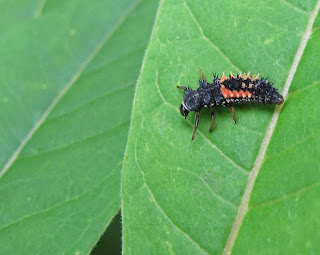What is more appropriate for Halloween than ghosts and pirates? We are not talking about trick-or-treat costumes, though, but spiders. Come to think of it, what is more appropriate for Halloween than spiders?! Just last week I found both kinds on an unseasonably warm night (October 21) here in South Deerfield, Massachusetts.
Both ghost spiders (family Anyphaenidae) and pirate spiders (family Mimetidae) prowl in search of prey. The similarity ends there, though, as they don’t resemble each other in the least, and their lifestyles are very different.
Ghost spiders are, not surprisingly, pale in color for the most part, and generally nocturnal in their habits, haunting foliage in pursuit of insects to eat. By day they hide in curled leaves that they tie together with silk.
Despite their name, ghost spiders are not very intimidating to humans. Adults reach a maximum of only a bit more than 8 millimeters.  This one, a specimen of Hibana gracilis, was probably about six millimeters in body length. Big enough to take down the midge it is munching on, though. I think spiders recognize on some level the attractiveness of outdoor lighting to insects, as that is the situation I found this one in, and the pirate spider as well.
This one, a specimen of Hibana gracilis, was probably about six millimeters in body length. Big enough to take down the midge it is munching on, though. I think spiders recognize on some level the attractiveness of outdoor lighting to insects, as that is the situation I found this one in, and the pirate spider as well.
Pirate spiders are easily identified by their four eye patches and two wooden legs. But seriously, folks, the long spines on their legs help differentiate them from the cobweb spiders and sheet-web weavers that they otherwise might be mistaken for. The resemblance to other spiders is further complicated by the fact that you sometimes find pirate spiders in the snares of cobweb weavers. Their appearance there is as sinister as their name suggests.
Pirate spiders eat cobweb spiders, as well as orb weavers and other spiders. They dispatch the rightful owner of the web by biting the other spider on its legs, feeding from one after the other until the victim is totally drained. One reason for attacking the legs of its prey might be that the jaws of pirate spiders are fused at their base, not permitting the spider to open its mouthparts wide enough to bite other parts of its victims.

The specimen I found last week was Mimetus puritanus, the most common species in the eastern United States. There is a total of fourteen species in the genus in North America, however, and another ten that remain undescribed (awaiting the assignment of names by arachnologists).
BOO! Just making sure you are still paying attention. Ar-r-r-r-g, matey! Be on the lookout for ghosts and pirates in your own neighborhood.

















